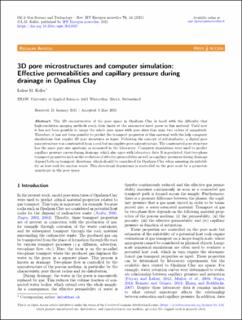Please use this identifier to cite or link to this item:
https://doi.org/10.21256/zhaw-23529| Publication type: | Article in scientific journal |
| Type of review: | Peer review (publication) |
| Title: | 3D pore microstructures and computer simulation : effective permeabilities and capillary pressure during drainage in Opalinus Clay |
| Authors: | Keller, Lukas M. |
| et. al: | No |
| DOI: | 10.2516/ogst/2021027 10.21256/zhaw-23529 |
| Published in: | Oil & Gas Science and Technology – Revue d’IFP Energies nouvelles |
| Volume(Issue): | 76 |
| Issue: | 44 |
| Issue Date: | 2021 |
| Publisher / Ed. Institution: | IFP Energies nouvelles |
| ISSN: | 1294-4475 1953-8189 |
| Language: | English |
| Subject (DDC): | 551: Geology and hydrology |
| Abstract: | The 3D reconstruction of the pore space in Opalinus Clay is faced with the difficulty that high-resolution imaging methods reach their limits at the nanometer-sized pores in this material. Until now it has not been possible to image the whole pore space with pore sizes that span two orders of magnitude. Therefore, it has not been possible to predict the transport properties of this material with the help computer simulations that require 3D pore structures as input. Following the concept of self-similarity, a digital pore microstructure was constructed from a real but incomplete pore microstructure. The constructed pore structure has the same pore size spectrum as measured in the laboratory. Computer simulations were used to predict capillary pressure curves during drainage, which also agree with laboratory data. It is predicted, that two-phase transport properties such as the evolution of effective permeability as well as capillary pressures during drainage depend both on transport directions, which should be considered for Opalinus Clay when assessing its suitability as host rock for nuclear waste. This directional dependence is controlled on the pore scale by a geometric anisotropy in the pore space. |
| URI: | https://digitalcollection.zhaw.ch/handle/11475/23529 |
| Fulltext version: | Published version |
| License (according to publishing contract): | CC BY 4.0: Attribution 4.0 International |
| Departement: | School of Engineering |
| Organisational Unit: | Institute of Computational Physics (ICP) |
| Published as part of the ZHAW project: | EURAD-WP-Gas: Mechanistic understanding of gas transport in clay materials |
| Appears in collections: | Publikationen School of Engineering |
Files in This Item:
| File | Description | Size | Format | |
|---|---|---|---|---|
| 2021_Keller_3d-pore-microstructures-computer-simulation.pdf | 3.57 MB | Adobe PDF |  View/Open |
Show full item record
Keller, L. M. (2021). 3D pore microstructures and computer simulation : effective permeabilities and capillary pressure during drainage in Opalinus Clay. Oil & Gas Science and Technology – Revue d’IFP Energies Nouvelles, 76(44). https://doi.org/10.2516/ogst/2021027
Keller, L.M. (2021) ‘3D pore microstructures and computer simulation : effective permeabilities and capillary pressure during drainage in Opalinus Clay’, Oil & Gas Science and Technology – Revue d’IFP Energies nouvelles, 76(44). Available at: https://doi.org/10.2516/ogst/2021027.
L. M. Keller, “3D pore microstructures and computer simulation : effective permeabilities and capillary pressure during drainage in Opalinus Clay,” Oil & Gas Science and Technology – Revue d’IFP Energies nouvelles, vol. 76, no. 44, 2021, doi: 10.2516/ogst/2021027.
KELLER, Lukas M., 2021. 3D pore microstructures and computer simulation : effective permeabilities and capillary pressure during drainage in Opalinus Clay. Oil & Gas Science and Technology – Revue d’IFP Energies nouvelles. 2021. Bd. 76, Nr. 44. DOI 10.2516/ogst/2021027
Keller, Lukas M. 2021. “3D Pore Microstructures and Computer Simulation : Effective Permeabilities and Capillary Pressure during Drainage in Opalinus Clay.” Oil & Gas Science and Technology – Revue d’IFP Energies Nouvelles 76 (44). https://doi.org/10.2516/ogst/2021027.
Keller, Lukas M. “3D Pore Microstructures and Computer Simulation : Effective Permeabilities and Capillary Pressure during Drainage in Opalinus Clay.” Oil & Gas Science and Technology – Revue d’IFP Energies Nouvelles, vol. 76, no. 44, 2021, https://doi.org/10.2516/ogst/2021027.
Items in DSpace are protected by copyright, with all rights reserved, unless otherwise indicated.